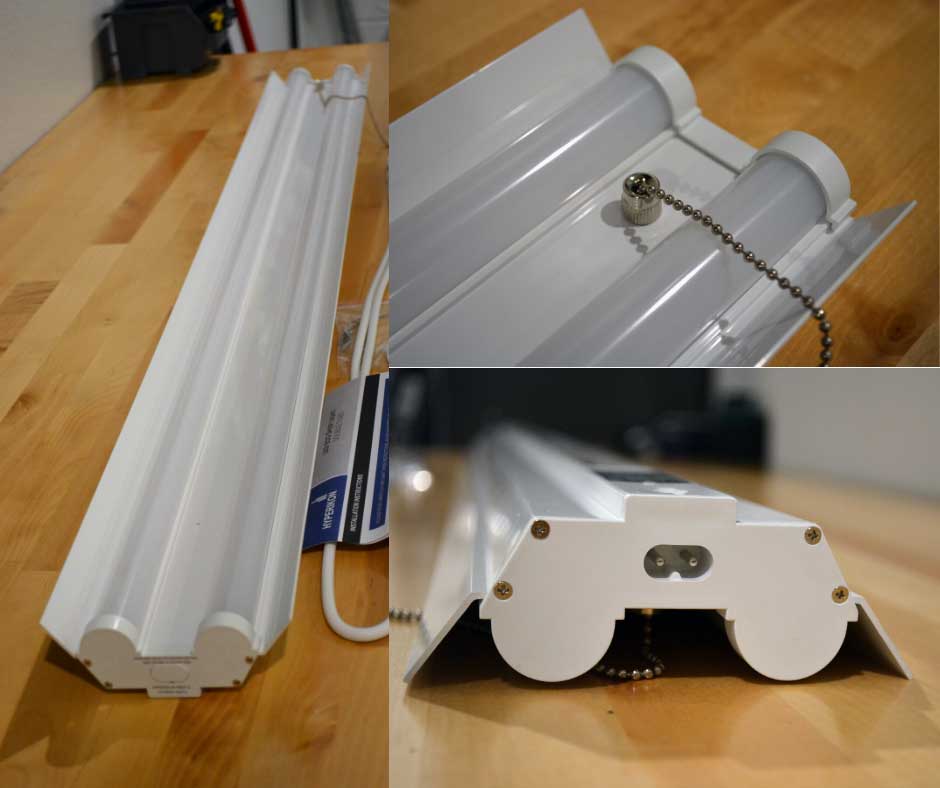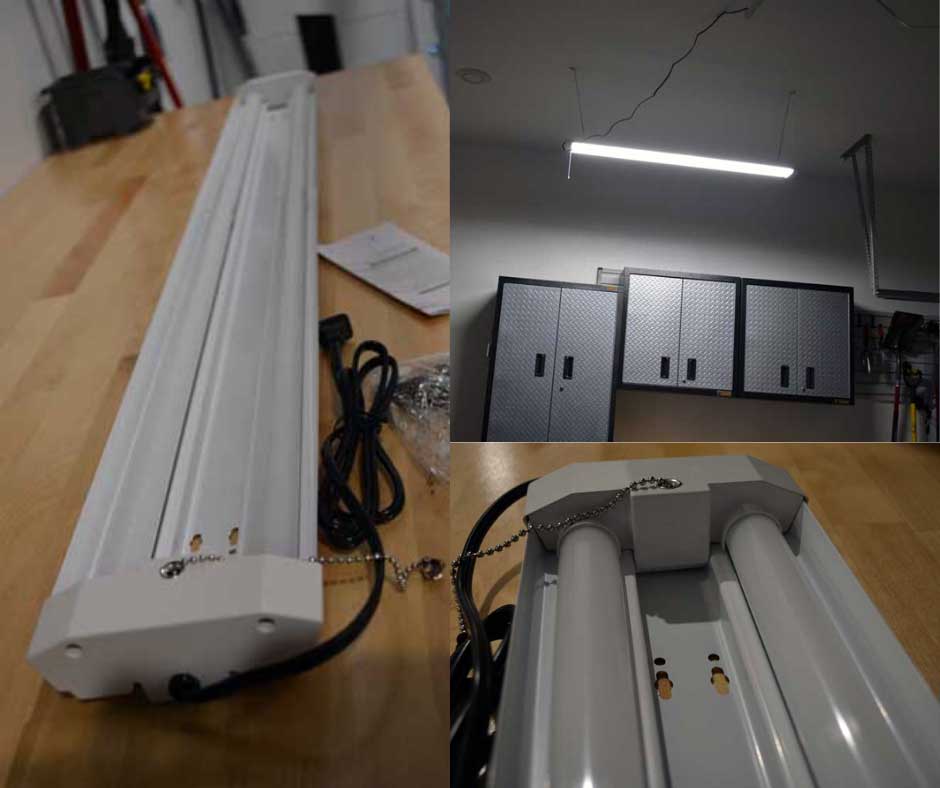How to Find the Best LED Shop Lights for Your Garage
I thought I’d dialed in my garage lighting all when we built our house. I asked the builder to add four additional recessed lights in the ceiling to make everything a little brighter.
It still wasn’t bright enough.
It’s obvious to me that a lot of the “Best Garage Lighting” guides out there are written by people who never bought the the different lights and probably never even seen them in person.
That wasn’t how I wanted to write this article.
What I did was I bought six of the highest rated LED shop lights on Amazon and put them all head-to-head.
I’ll go into a little more detail in the next section. But if you’ve already run out of patience and just want to skip to the end…
What Makes This Review Different?
I purchased six of the highest rated LED shop lights on Amazon at full retail price. No product was provided by the manufacturers and nobody is paying me for this review. The goal was simply to find which of these LED shop lights worked best in my garage.
So with that out of the way, let me present what I think are the two best LED shop lights. The only difference is whether you want to hardwire your lights or use the simpler plug-and-play options.
Best of the Best LED Shop Lights
Best Hardwired LED Shop Light: Hykolity SL4FT40W5K
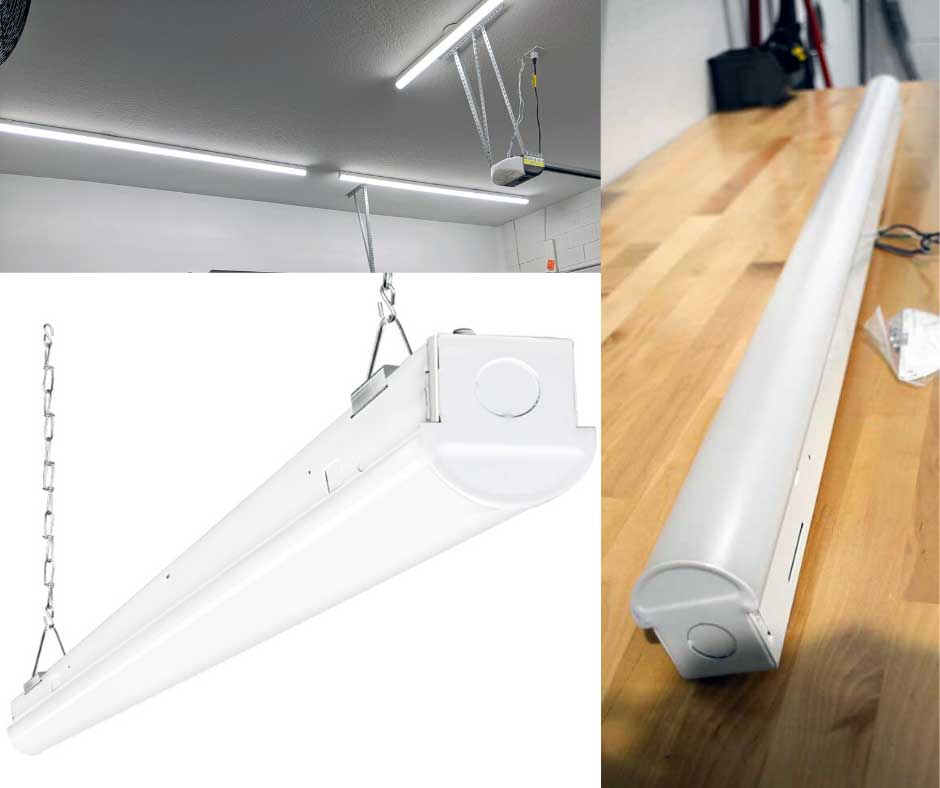
I was thrilled when I found out these fixtures were hardwired because they made for the perfect solution for my garage. (Check out my Hykolity lighting installation here!)
These lights come in both 4′ and 8′ fixtures, and I’m using both in my garage. The 8′ high output fixture puts out an amazing 14,300 lumens for 110 watts. This allowed me to get a whopping 62,000 lumens out of only five fixtures.
For my detailed review of the Hykolity LED strip lights, check out my detailed review where I compare two Hykolity fixtures head to head against each other.
Specs:
⦿ 5200 (4′) – 14,300 (8′) Lumens
⦿ 5000 Kelvin color temperature
⦿ 40 Watts power consumption
⦿ 80+ CRI
⦿ 110º beam angle
Why they’re amazing:
⦿ 130 Lumens per Watt
⦿ 130 Lumens per Dollar
Best Plug-In LED Shop Light: Hyperikon HyperFixture 4C-50S

I loved the Hyperikon Hyperfixture lights the moment I took them out of the box. These fixtures have a heavy gauge brushed aluminum fixture that looks simply amazing.
These lights have a slightly higher CRI than the Hykolity lights and a wider beam angle. Their only drawback is that I would have needed more Hyperikon fixtures to get the same amount of total lumens.
These were head and shoulders above everything else until I saw that the Hykolity lights could be hardwired. But if you’re looking for LED shop lights that plug into a regular outlet, then I highly recommend the Hyperikon Hyperfixture lights.
I also have a great head-to-head comparison for two Hyperikon LED fixtures that you can check out here!
Specs:
⦿ 4580 Lumens
⦿ 5000 Kelvin color temperature
⦿ 35 Watts power consumption
⦿ 84+ CRI
⦿ 140º beam angle
Why they’re amazing:
⦿ 131 Lumens per Watt
⦿ 129 Lumens per Dollar
Looking for Garage Lighting is Hard
One of the most popular threads on the Garage Journal forum is over 115 pages long and has over TWO THOUSAND REPLIES!
That’ll take you a couple of days to read, never mind sifting through everyone’s opinions and deciding which is the right light for you.
That’s why I put off upgrading my garage lighting for so long. There’s just so many options and so much to learn.
I didn’t want to make the wrong choice.
The fact is though, nothing will make more of an impact to your garage than good lighting.
Comparing the Best LED Shop Lights
I had a couple of rules for this contest because I don’t have infinite time or money to test every light there is.
Rule #1: Everything needed to be available on Amazon. Yes, I know there are plenty of other lighting stores out there, and some of them are really good. But I wanted LED shop lights that were available from someplace that everyone trusted.
Rule #2: I only looked at all-in-one LED shop lights, not separate fixtures and bulbs. Most garages will be just fine with low-cost\high-output LED shop lights.
Rule #3: The price per fixture ranges between $20 and $40. Like most normal people, cost is a factor so I want to get the most brightness for my buck. Or, if you’re Canadian, lumens for your loonie. 
Rule #4: All of the lights would have a color temperature of 5000K, with one exception so I could see the difference. For more on what that means, I wrote an article that goes into detail what color temperature garage lighting should be.
And that’s it. Pretty simple, right?
Rules Of The Contest
There’s three important specs you need to pay attention to for LED shop lights.
Those are price, wattage and lumens.
Wattage is a measure of how efficient the light is. The higher the number of watts, the more energy the light uses.
Lumens measures how bright the light is. The higher number, the brighter the light is.
In order to tell if one fixture is better than another, I created two other metrics. They help clear things up if you’re looking at LED shop lights with different specs.
Efficiency (L/W): This is simply the number of lumens divided by the number of Watts. A light that is super bright (high lumens) but uses a lot of energy (high wattage) may score less than a light with lower lumens that doesn’t use as much energy.
Value (L/$): This takes the number of lumens divided by the price. A light that is very expensive needs to be extremely bright (high lumens) to be a good value.
| Manufacturer | Model | Color temp | Watts | Lumens | L/W | Price | L/$ |
| Hyperikon | 921141051 | 5000K | 35 | 4580 | 131 | 35.45 | 129 |
| Hykolity | SL4FT40W5K-S | 5000K | 40 | 5200 | 130 | 39.99 | 130 |
| FrenchMay | SY-LED-ZJD | 5000K | 40 | 4800 | 120 | 42.97 | 112 |
| Barrina | INWT504020650Ac | 6500K | 20 | 2200 | 110 | 20.99 | 105 |
| Hykolity | HY-SP4F-4 | 5000K | 40 | 4200 | 105 | 29.99 | 140 |
| Hyperikon | 922301051 | 5000K | 40 | 4000 | 100 | 29.95 | 134 |
| LLT | LVP5M-4N3650 | 5000K | 36 | 2700 | 75 | 32.39 | 83 |
Of course these three metrics aren’t the be-all-end-all of buying garage lighting.
The overall goal is to get the best LED shop light for the money.
Note, this is NOT the best light if money isn’t a factor. It is also NOT the best cheap light. A light that is super bright but costs a little more will be rated higher than a cheap light that’s not as bright.
When you’re shopping for something as major as garage lighting, it’s critical that you do a little homework ahead of time. You’ll want to get a good idea of how many lights you’ll need and how you’re going to arrange those lights in your garage.
The Best of the Rest: LED Shop Light Shootout
3rd Place: Hykolity HY-SP4F-4
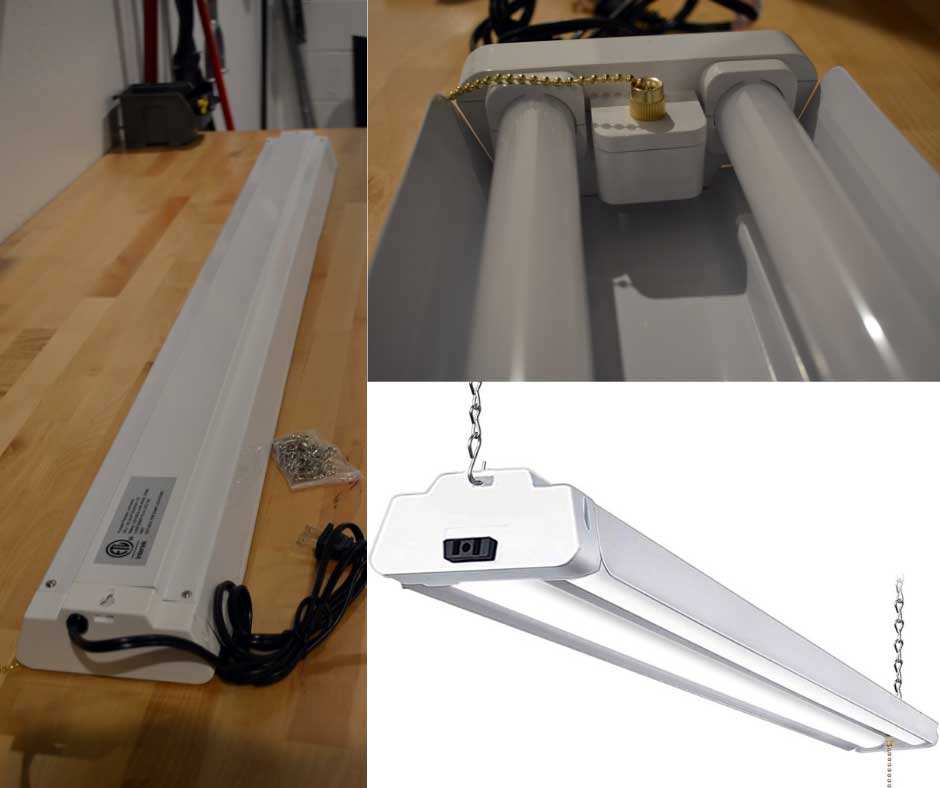
The second entry from Hykolity on this list scores very high because they output a lot of light for not a lot of money.
They’re bigger than the SL4FT40W5K hardwired LED lights which won this contest and about $10 cheaper per fixture. But the build quality isn’t quite up to the same standards. The fixture itself is thinner and more flexible.
Still, if you want the highest output light per dollar, look no further than the Hykolity HY-SP4F.
You can find more details in my Hykolity LED light head-to-head shootout review here.
Specs:
⦿ 4200 Lumens
⦿ 5000 Kelvin color temperature
⦿ 42 Watts power consumption
Why they’re amazing:
⦿ 105 Lumens per Watt
⦿ 140 Lumens per Dollar
4th Place: Hyperikon 922301051
Hyperikon makes really good LED shop lights and I did a great comparison between these lights and their HyperFixture 4C-50S that was one of the winners.
If you have the option of getting the 4C-50S, definitely opt for those lights instead of these. You’ll still get those awesome Hyperikon light bulbs, but you’ll also get a much better brushed aluminum fixture than these lights have.
In my opinion, there’s no reason to buy the 922301051 instead of the HyperFixture 4C-50S.
Specs:
⦿ 4000 Lumens
⦿ 5000 Kelvin color temperature
⦿ 40 Watts power consumption
Why they’re amazing:
⦿ 100 Lumens per Watt
⦿ 134 Lumens per Dollar
5th Place: FrenchMay SY-LED-ZID
The FrenchMay LED shop lights are one of the highest ranked lights on Amazon, so it’s natural to include them in this roundup.
So I was shocked when they only managed 5th place overall. But you only need to look at the pricetag to see why.
The FrenchMay lights have an excellent Lumen to Watt ratio, beaten only by by our two winners, the Hykolity and Hyperikon garage lights. Where they lose out is their price. They’re around $10 more expensive than any other light on this list.
For more on the FrenchMay LED lights, check out my full review here.
Specs:
⦿ 4800 Lumens
⦿ 5000 Kelvin color temperature
⦿ 40 Watts power consumption
⦿ 80+ CRI
⦿ 120º beam angle
Why they’re amazing:
⦿ 120 Lumens per Watt
⦿ 112 Lumens per Dollar
6th Place: Barrina INWT504020650Ac
Let me say right at the start that I really love these lights, even though they’re in 6th place.
The trouble is that they’re not very good at being an overhead garage light. They’re about half the power of any other light on this list. They’re lumens per watt and lumens per dollar are all at the bottom of the chart.
So why do I love them? Because they’re one of the best under cabinet lights that I’ve ever seen!
They’re amazingly clear and bright. The 6500 Kelvin color temperature gives off a bit of a blue-ish hue, but if you’re using it for task lighting, you won’t really notice it.
You will notice how crystal clear everything looks however.
For more on the Barrina LED shop lights, check out my full review here. They may not be good for overhead lighting, but I still highly recommend these lights.
Specs:
⦿ 2200 Lumens
⦿ 6500 Kelvin color temperature
⦿ 20 Watts power consumption
Why they’re amazing:
⦿ 110 Lumens per Watt
⦿ 107 Lumens per Dollar
Garage Lighting Guide
Are LED Shop Lights Better Than Fluorescent?
It used to be that fluorescent lights dominated the industry. You could buy them in four foot or eight foot tubes and the fixtures themselves were fairly inexpensive. They were also more efficient to operate, watt for watt, than the incandescent lights we used in our homes.
As time went on and lighting technology got better, LED’s have replaced fluorescent lights in many industrial settings.
LED’s are much more efficient
LED shop lights typically consume about 50% of the power of comparable fluorescent lights. It’s common to see fluorescent T5 bulbs using 14-80 watts or higher. Comparable LED light bulbs use around 14 watts per bulb.
LED lights last longer
On average, LED lights last twice as long as comparable fluorescent light bulbs!
For those of you who want solid numbers, the lifespan of the average T5 fluorescent bulb is around 24,000 hours while the lifespan for LED bulbs is approximately 50,000 hours. (Source)
LED lights are dimmable
Because, sometimes, you just don’t need full brightness on every light.
Now, I don’t want to imply that fluorescent lights aren’t dimmable. They are, but there are some caveats that make it impractical.
In most cases, you need a special ballast in the fixture and a bulb that is also dimmable. Both of which are rare.
By contrast, it’s much more common to find dimmable LED lights. In fact, the Hykolity lights that I use in my garage are dimmable.
LED lights work better with motion sensors
In theory, a motion sensor will save on electricity costs by only turning on the light when there’s someone in the room. But if you plan on using motion sensors with your garage lights, you’ll want to steer clear of fluorescent bulbs entirely.
That’s because the lifespan of a fluorescent light bulb is tied to how many times it turns on and off. Generally speaking, you save on energy costs by turning a light off “frequently” but you’ll be spending more on money to replace the bulbs “more” frequently. (Source)
What color temperature do I need?
The best way to think about a LED shop light’s color temperature is how yellow or white your lights are.
A LED light’s color temperature ranges from 3000 K to 6500 K. The ‘K’ stands for degrees Kelvin (k).
Lower color temperatures take on a more yellowish hue while higher color temperatures take on a blueish hue.
A light in the 4200K range will have a distinctly yellow hue. It’s relaxing, but you may find yourself quickly losing focus. By contrast, a light at 6000K or above will be noticeably blue in tint. Details will be extremely clear, but your eyes will tire out quickly.

Some hobbies, such as woodworking, will want a slightly warmer color temperature, but almost every other use case will require clear, cool light.
In the garage, you’ll want a light that is as close to natural daylight as possible. That means the sweet spot for garage lighting is between 5000 and 5500 Kelvin.
At that color temperature, it’ll give off a bright white light that clearly lights up what you’re working on, but isn’t so harsh that it’ll strain your eyes.
For more on choosing a lighting color temperature that works for your garage, check out my in-depth article where I discuss what different color temperatures look like. I also give some color temperature recommendations depending on how you’re going to use your garage.
How many lumens do you need?
Lighting is rated by something called lumens. The more lumens the light has, the brighter it is. I wrote an article that’s explains how to quickly calculate how many lumens you need to light your garage. I recommend checking it out.
Essentially, you want between 130-150 lumens per square foot for general lighting in your garage. If you have an area where you’re doing detail work, that area should have about 300 lumens per square foot.
For example, my 24′ x 20′ garage will have a total of 480 sq ft of space. For general lighting, I should have a total of between 62,400 and 72,000 lumens for my garage.
How to arrange the lights
Generally speaking, there are two basic types of lighting: general lighting and task lighting.
Task lighting illuminates small areas in brighter, more focused light while general lighting illuminates the entire room.
Choosing the right beam angle is important so your lights won’t cast shadows on your wall. Because of the height of most residential garages, that means picking a light lighting with a broad beam angle.
A narrower beam angle would be used for higher ceilings, such as in a warehouse or barn. The narrower beam angle is needed to project the light over a greater distance to the floor.
For most residential garages with ceilings up to 10′ high, the best beam angle for LED shop lights will be between 90º and 120º. If you have ceilings above 14′ high, you’ll want a more narrow beam angle between 60º and 90º.
It’s worth noting that all of these LED shop lights have broader beam angles, designed for residential garage ceilings.
What is a Good CRI for LED Lights?
CRI, or Color Rendering Index is a measure of how accurate the color appears in a given light source when compared to a reference light source.
Usually that reference light source is how the item appears outside during normal daylight.
The CRI is measured on a scale of 1 to 100. Anything with a CRI higher than 80 is considered good and CRI’s higher than 90 are excellent.
To give you a better idea of what this mean for you, take a look at this image. It compares how strawberries look under a light with a CRI of 75 and a light with a CRI of 95.
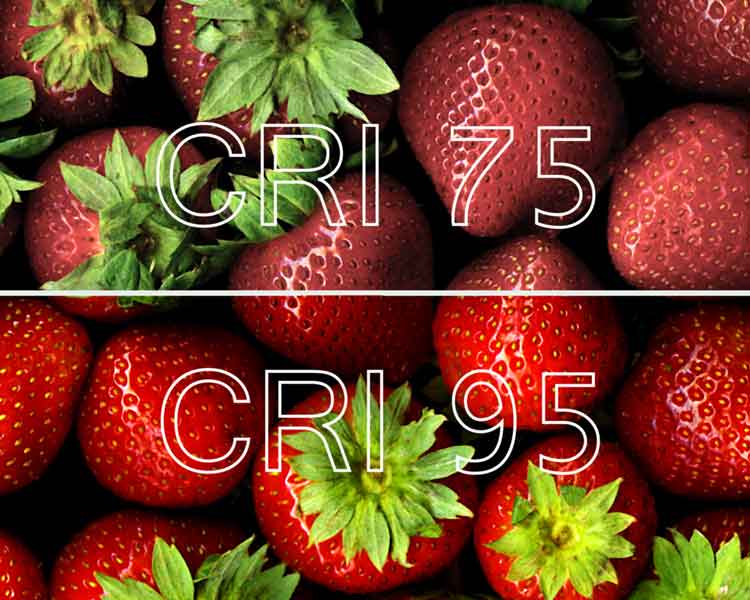
As you can see, the colors look more vibrant in the
For most people, anything over a CRI of 80 is great. People who need extremely accurate color representation, like automotive detailers or artists would need a light with a CRI as close to 100 as possible.
Can You Put Recessed Lighting in Garages?
Absolutely! In fact, I actually had recessed lighting in my garage for almost three years before I installed my Hykolity shop lights.
Recessed lights are a great lighting solution that’s easy to install in any room. The challenge with using recessed lights, is that they don’t output enough light to light up a room as large as a two-car garage.
We’ve already seen that you need between 62,000 and 72,000 lumens to light up a two car garage. In my garage, I hit that number with four eight foot and one four foot LED shop lights.
To get 60,000 lumens of light from the Phillips Hue recessed lights I have inside my house, I’d need A WHOPPING NINETY LIGHTS. That’s a total cost of over $3000 dollars in lights that use over 700 watts of power!
I love recessed lighting, but I found that my garage simply wasn’t the right application for me. Even adding additional lights to my garage, I found the lighting was dimmer than I wanted. That’s what started this entire process for me.
What is a Vapor Proof Light?
When I was shipping for LED shop lights, I kept seeing the term ‘vapor proof’ come up. I didn’t understand what it meant, so I turned to my trusty translator (i.e. Google) to figure out what it meant.
A vapor proof light is one that’s designed for a harsher environment than you’d need in a typical residential garage Vapor proof lights are used in manufacturing facilities, swimming pools, barns or subways.
Personally, I don”t see much of a use case for vapor proof lights in home garages. I can understand using them if you have an outdoor carport that’s exposed to the elements, but that’s about it.
Final Thoughts
I set out to find the best LED shop lights to illuminate my entire garage, but also ended up finding a really good task light in the Barrina LED light that I use above my Gladiator workbench.
The biggest wins were the Hykolity lights that now light up my garage and the Hyperikon lights that I installed in my attic.
This was a really fun experiment to do and I ended up finding place to use all but one of the lights in my house.
The post How to Find the Best LED Shop Lights for Your Garage appeared first on Garage Transformed.

